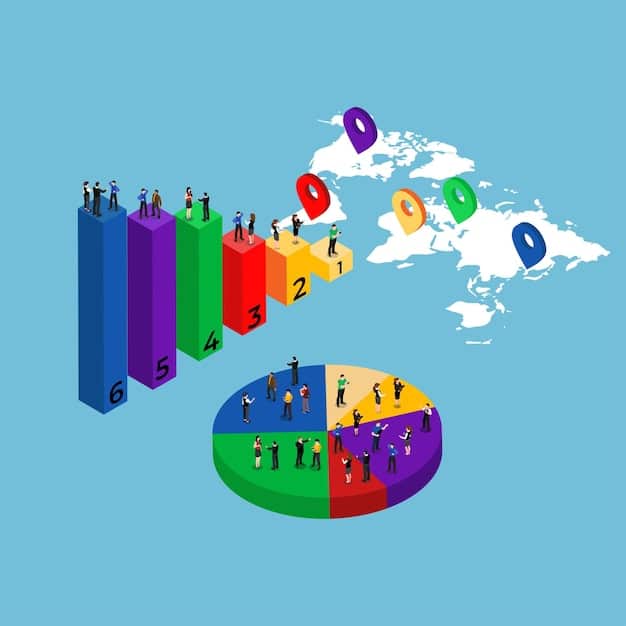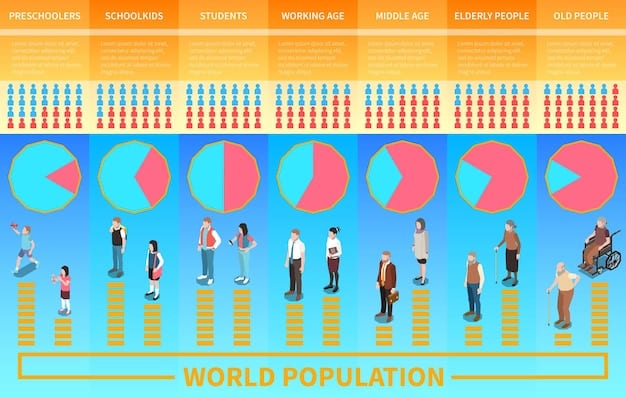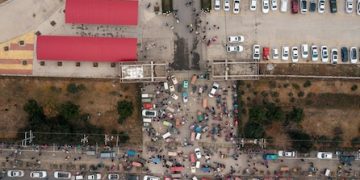Demographic Shifts: Understanding the Impact on US Labor Markets

Understanding the impact of demographic shifts in developed countries on US labor markets is crucial for forecasting labor force participation, skills demand, and potential policy interventions, as aging populations and changing birth rates reshape workforce dynamics.
Demographic shifts in developed countries are having profound and multifaceted effects on labor markets worldwide. Understanding the impact of demographic shifts in developed countries on US labor markets is paramount for policymakers, businesses, and individuals alike to adapt to the evolving economic landscape.
Understanding Demographic Shifts in Developed Countries
Demographic shifts encompass changes in population size, structure, and distribution. These shifts are largely influenced by factors such as birth rates, death rates, and migration patterns. In developed countries, a common trend is population aging, characterized by declining birth rates and increasing life expectancy.
These demographic changes are not isolated events; they have far-reaching implications for various aspects of society, including healthcare, social security systems, and, most notably, labor markets. The aging of populations in developed countries is creating a significant challenge for the US labor market.
Key Factors Driving Demographic Shifts
Several interconnected factors contribute to the demographic shifts observed in developed nations. Identifying these factors is critical to understanding the potential impacts on the US labor market.
- Declining Birth Rates: Lower fertility rates mean fewer young people entering the workforce in the future.
- Increasing Life Expectancy: People are living longer, which increases the proportion of older individuals in the population.
- Migration Patterns: Immigration can offset some of the effects of declining birth rates, but it also introduces new dynamics to the labor market.
These shifts are not uniform across all developed countries, and the specific impacts on the US labor market can vary depending on the interaction of these factors. For example, countries with more generous social welfare systems may experience different labor market outcomes compared to those with less extensive support.
In conclusion, understanding the forces behind demographic shifts is essential for anticipating and responding to their potential effects on the US labor market. This includes the need for policies that promote labor force participation among older workers and investments in education and training to address skills gaps.
The Aging Workforce in the United States
One of the most significant demographic trends impacting the US labor market is the aging of the workforce. As the baby boomer generation retires, the proportion of older workers in the labor force is increasing, while the proportion of younger workers is declining.
This shift has profound implications for productivity, innovation, and the overall health of the economy. The loss of experienced workers can create skills gaps and reduce knowledge transfer within organizations. Additionally, an aging workforce may require different types of jobs and working arrangements.

Impact on Key Industries
The aging workforce is not impacting all industries equally. Some sectors, such as healthcare and social assistance, are experiencing particularly acute labor shortages due to the increased demand for services from an aging population. Other sectors, such as manufacturing and construction, may face challenges in replacing retiring skilled workers.
To mitigate these impacts, businesses and policymakers need to develop targeted strategies that address the specific challenges facing different industries. This may include investments in training and apprenticeship programs, efforts to attract and retain older workers, and reforms to immigration policies.
- Healthcare: Increased demand, shortage of healthcare professionals.
- Manufacturing: Loss of skilled labor, need for automation.
- Construction: Difficulty in recruiting younger workers, aging of the existing workforce.
Addressing the challenges posed by an aging workforce requires a multi-faceted approach that combines workforce development initiatives, technological innovation, and policy reforms. Without these efforts, the US economy may struggle to maintain its competitiveness in the global marketplace.
In summary, the aging workforce trend in the United States presents both challenges and opportunities. By understanding the specific impacts on different industries and implementing targeted strategies, it is possible to mitigate the negative consequences and harness the potential benefits of an older, more experienced workforce.
Declining Birth Rates and the Shrinking Labor Pool
Another critical demographic trend affecting the US labor market is declining birth rates. The fertility rate in the United States has been below the replacement rate for several decades, meaning that the population is not producing enough children to maintain its current size without immigration.
This trend has significant implications for the size and composition of the future workforce. A smaller pool of young workers entering the labor market can lead to labor shortages, reduced economic growth, and increased competition for talent.
Strategies to Counteract the Decline
Several strategies can be employed to counteract the negative effects of declining birth rates on the labor market. These include increasing labor force participation among underrepresented groups, promoting immigration, and investing in education and training to boost worker productivity.
Encouraging greater participation in the labor force among women, minorities, and individuals with disabilities can help to fill the gaps left by declining birth rates. Immigration can also play a vital role in replenishing the labor pool, particularly in sectors facing critical shortages.
- Promote Family-Friendly Policies: Support for childcare, parental leave.
- Immigration Reform: Attract skilled workers from abroad.
- Invest in Education: Improve skills and productivity of the workforce.
Addressing the challenge of declining birth rates requires a long-term perspective and a commitment to policies that support families, promote immigration, and invest in human capital. Failure to address this issue could have severe consequences for the future of the US economy.
In conclusion, declining birth rates pose a significant threat to the US labor market. By implementing proactive policies that encourage labor force participation, promote immigration, and invest in education, it is possible to mitigate the negative impacts and ensure a strong and vibrant economy for future generations.
The Role of Immigration in the US Labor Market
Immigration has long been a source of labor and economic growth in the United States. Immigrants contribute to the labor force, start businesses, and pay taxes, helping to support the economy and offset the effects of declining birth rates and an aging population.
However, immigration is also a complex and controversial issue, with debates over its impact on wages, employment, and social cohesion. Understanding the role of immigration in the US labor market requires a nuanced perspective that considers both the benefits and the challenges.
Benefits and Challenges of Immigration
Immigration can provide several benefits to the US labor market, including filling labor shortages, boosting innovation, and increasing economic growth. Immigrants often take jobs that native-born workers are unwilling or unable to do, particularly in sectors such as agriculture, construction, and healthcare.

However, immigration can also pose challenges, such as downward pressure on wages in some sectors and increased competition for jobs. It is essential to implement policies that ensure immigrants are integrated into the labor market and that their rights are protected.
- Filling Labor Shortages: Immigrants often take jobs that native-born workers avoid.
- Economic Growth: Immigrants start businesses and pay taxes.
- Wage Depression: Potential downward pressure on wages in some sectors.
To maximize the benefits of immigration and minimize the challenges, policymakers should focus on creating a fair and efficient immigration system that attracts skilled workers, protects the rights of all workers, and promotes economic growth. This includes investing in education and training programs that help immigrants acquire the skills they need to succeed in the US labor market.
In summary, immigration plays a crucial role in the US labor market, providing both benefits and challenges. By implementing sensible policies that address these issues, it is possible to harness the potential of immigration to strengthen the economy and promote social cohesion.
Policy Implications and Future Outlook
Given the significant impact of demographic shifts on the US labor market, it is essential for policymakers to develop proactive strategies that address the challenges and capitalize on the opportunities. This requires a comprehensive approach that considers the interplay of various demographic trends and their effects on different sectors of the economy.
Some key policy implications include reforms to social security and healthcare systems to accommodate an aging population, investments in education and training to address skills gaps, and immigration reforms that attract skilled workers and promote economic growth.
Adaptation and Innovation
Businesses also have a critical role to play in adapting to demographic shifts. This includes implementing flexible work arrangements to attract and retain older workers, investing in automation and technology to improve productivity, and diversifying recruitment strategies to tap into underutilized labor pools.
Innovation is also key to addressing the challenges posed by demographic shifts. This includes developing new technologies that can improve the productivity of older workers, creating new products and services that cater to the needs of an aging population, and finding new ways to deliver education and training to a diverse workforce.
- Social Security Reform: Adjustments to retirement age and benefits.
- Healthcare Innovation: Focus on preventative care and chronic disease management.
- Workforce Development: Training and apprenticeships for in-demand skills.
The future of the US labor market will be shaped by the choices we make today. By taking proactive steps to address demographic shifts, we can ensure a strong and vibrant economy for generations to come. This requires a collaborative effort involving government, businesses, and individuals.
In conclusion, demographic shifts in developed countries are having an undeniable impact on the US labor market. By understanding these trends and implementing targeted policies, it is possible to mitigate the challenges and harness the opportunities for a more prosperous future.
Innovative Solutions and Adaptations for US Businesses
With the looming demographic shifts putting pressure on the US labor market, businesses must become proactive in adapting to survive and thrive. Innovation and adaptation are fundamental to ensure companies can maintain productivity and competitiveness.
This involves exploring strategies to attract and retain employees across different age groups, leveraging technology to enhance efficiencies as well as creating diverse inclusive workplaces.
Strategies to Implement
Businesses can implement tailored strategies to counter demographic shift impacts, including flexible work arrangements, strategic technology implementations and inclusive growth programs.
Such proactive approaches allow firms to mitigate productivity concerns, attract new talent, retain experienced workers as well as adapt to new market challenges.
- Flexible Work Arrangements: Telecommuting, flexible hours.
- Technology Implementation: Automation and artificial intelligence.
- Inclusive Growth Programs: Diversity and inclusion policies.
In conclusion, businesses that adapt strategically to demographic induced changes, will be better positioned to sustain competitiveness and succeed in future economic scenarios.
| Key Aspect | Brief Description |
|---|---|
| 👴 Aging Workforce | The proportion of older workers is increasing, causing skills gap. |
| 👶 Declining Birth Rates | Lower birth rates lead to a smaller pool of young workers entering the labor market. |
| 🌍 Immigration | Immigration helps fill labor shortages and boosts economic growth. |
| 🏢 Policy Adaptations | Reforms to social security, healthcare, and immigration policies are needed. |
| Key Aspect | Brief Description |
|---|---|
| 👴 Aging Workforce | Proportion of older workers is increasing, causing skills gap. |
| 👶 Declining Birth Rates | Lower birth rates lead to a smaller pool of young workers entering the US labor market. |
| 🌍 Immigration | Immigration helps fill labor shortages and boosts economic growth in the US. |
| 🏢 Policy Adaptations | Reforms to social security, healthcare, and immigration policies are needed. |
FAQ Section
▼
The key demographic shifts include an aging workforce, declining birth rates, and changing immigration patterns, each presenting unique challenges and opportunities.
▼
An aging workforce can lead to reduced productivity due to physical limitations and a potential lack of up-to-date skills, necessitating continuous training.
▼
Immigration can help fill critical labor shortages, particularly in sectors where native-born workers are scarce, contributing to economic stability.
▼
Policy changes may include raising the retirement age, incentivizing part-time work for seniors, and providing healthcare and social support to older workers.
▼
Businesses can adapt by investing in automation, enhancing employee retention strategies, and promoting diversity to expand the labor pool and maintain productivity.
Conclusion
In conclusion, understanding the impact of demographic shifts in developed countries on US labor markets is critical for policymakers and businesses alike in the US. Addressing these shifts requires proactive strategies to mitigate challenges and capitalize on new opportunities for sustained and equitable economic growth.





